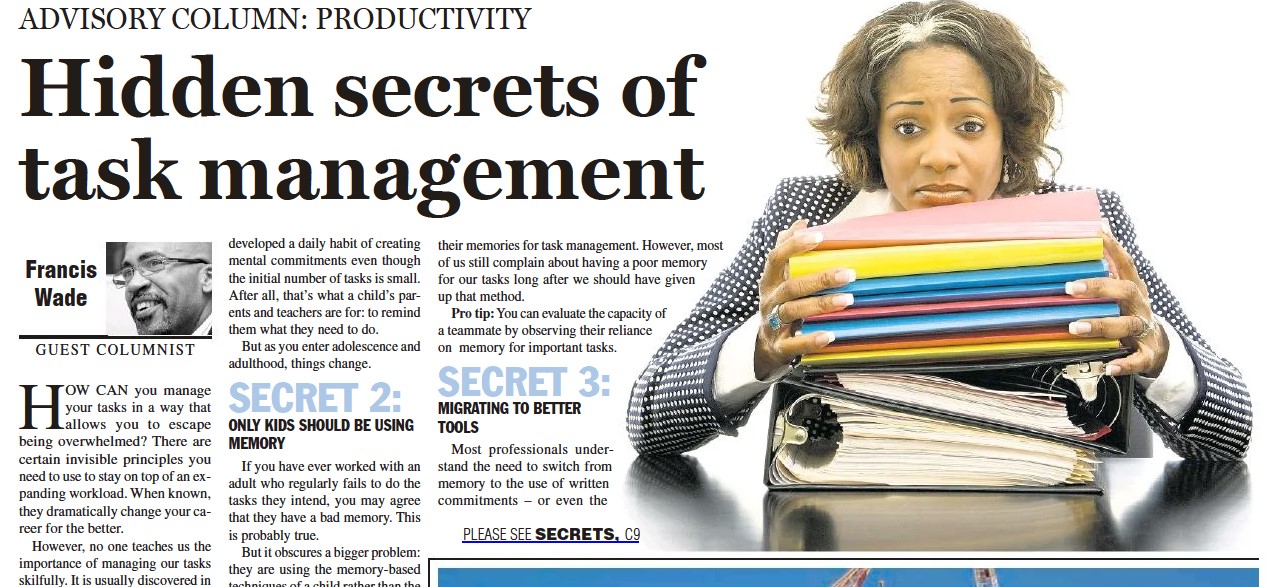How can you manage your tasks in a way that allows you to escape overwhelm? There are certain invisible principles you need to use to stay on top of an expanding workload. When known, they dramatically change your career for the better.
However, no-one teaches us the importance of managing our tasks skillfully. It’s usually discovered in the breach: when life isn’t working the way we want and we scramble for answers. Instead, most live on auto-pilot, never questioning why they do things the way they do. Let’s make some of these secrets conscious.
Secret 1 – Tasks Come from the Inside
What is a task? In its purest form, it belongs to a class of “psychological objects” that can’t be touched or seen, but still have an emotional weight. That’s because they come from within: each one is born when you quietly assign yourself an action to be completed in the future.
This is a self-taught practice. Around the age of seven, someone teaches you how to tell time. You realize it’s a great resource and start to create tasks which can only be executed later.
At first, all this takes place in your mind. Before long, you have developed a daily habit of creating mental commitments, even though the initial number of tasks is small. After all, that’s what a child’s parents and teachers are for: to remind them what they need to do.
But as you enter adolescence and adulthood, things change.
Secret 2 – Only Kids Should Be Using Memory
If you have ever worked with a full adult who regularly fails to do the tasks they intend, you may agree that they have a “bad memory”. This is probably true.
But it obscures a bigger problem: they are using the memory-based techniques of a child, rather than the grown-up methods of an adult. Here’s why so many get stuck.
As I mentioned, you are a self-taught task manager. However, as you grew out of your teenage years, the number of tasks increased, but your approach remained the same: to habitually use your memory.
Before long, you started to experience problems. Overwhelm crept in as you struggled to prevent promises from being broken and appointments from being missed. The harder you tried to remember, the worse things became.
Perhaps you got lucky and a parent or friend intervened, or maybe you figured out the changes you needed to make on your own. Instead of relying on memory, you began to write down all your tasks on paper or a smartphone. In either case, you stopped trying to use a Band Aid to heal an amputation, and switched your approach for the better.
The fact is, most adults have lives which are too complex to be using their memories for task management. However, most of us still complain about having a poor memory for our tasks, long after we should have given up that method.
Pro Tip: you can evaluate the capacity of a teammate by observing his/her reliance on memory for important tasks.
Secret 3 – Migrating to Better Tools
Most professionals understand the need to switch from memory to the use of written commitments (or even the employment of an administrative assistant). However, they don’t realize that this should be the first of many transformations. Research shows that your appetite to manage more tasks is insatiable: successful solutions lead to greater task loads.
These volume increases inevitably make you hit new limits. Consequently, whenever you experience symptoms of overwhelm and other task management problems, you should analyze your current combination of tools and behaviors. They must be upgraded to keep up with an increased number of tasks.
Unfortunately, this is simpler than it sounds. For example, you might recall the age when you shifted to writing down your tasks on an aid like Post-It notes. Since then, you moved on to using digital tools, but let’s imagine that you recently started noticing that familiar feeling of falling behind.
You may be tempted to believe that a return to Post-It notes would help, but here’s the surprise: it won’t. That approach was useful at a lower task volume, but cannot fit your adult life.
Now, you must perform a fresh analysis of your entire self-taught system. Look for small changes to make which together can give you brand new, added capacity. Do the research and experiment with different suggestions and technologies before settling on an upgraded approach.
But the best benefit is that now you’ll know that whenever you feel overwhelmed, the answer is never to revert to what worked for you in the past. Instead, you must go forward to adopt behaviors which are suitable for a future of even more tasks, and less overwhelm.









